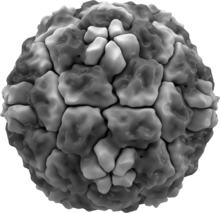
Back فيروس أنفي Arabic فيروس انفى ARZ رانیوویروس AZB Рынавірусы Byelorussian রাইনোভাইরাস Bengali/Bangla Rinovirus Catalan Rhinovirus Czech Rhinovirus Danish Rhinoviren German Rinovirusoj Esperanto
| Rhinovirus | |
|---|---|

| |
| Rhinovirus | |
| Scientific classification | |
| (unranked): | Virus |
| Realm: | Riboviria |
| Kingdom: | Orthornavirae |
| Phylum: | Pisuviricota |
| Class: | Pisoniviricetes |
| Order: | Picornavirales |
| Family: | Picornaviridae |
| Genus: | Enterovirus |
| Groups included | |
| |
| Cladistically included but traditionally excluded taxa | |
| |
The rhinovirus (from the Ancient Greek: ῥίς, romanized: rhis "nose", gen ῥινός, romanized: rhinos "of the nose", and the Latin: vīrus) is a positive-sense, single-stranded RNA virus belonging to the genus Enterovirus in the family Picornaviridae. Rhinovirus is the most common viral infectious agent in humans and is the predominant cause of the common cold.[1]
The three species of rhinovirus (A, B, and C) include at least 165 recognized types that differ according to their surface antigens or genetics.[2] They are among the smallest viruses, with diameters of about 30 nanometers. By comparison, other viruses, such as smallpox and vaccinia, are around ten times larger at about 300 nanometers, while influenza viruses are around 80–120 nm.
Rhinoviruses are transmitted through aerosols, respiratory droplets, fomites, and direct person-to-person contact.[3] They primarily infect nasal epithelial cells in the airway and cause mild symptoms such as sore throat, cough, and nasal congestion.[4][5] However, rhinovirus infection can cause more severe disease in infants,[6][7] the elderly, and the immunocompromised. Rhinoviruses are also recognized as a major cause of asthma exacerbations.[8]
As of April 2024, there are no FDA-approved vaccines or antiviral treatments for rhinovirus infection.[5]
- ^ "Rhinovirus (Common Cold) | Disease Outbreak Control Division". health.hawaii.gov. Retrieved 2024-11-20.
- ^ "Genus: Enterovirus | ICTV". ictv.global. Retrieved 2023-12-29.
- ^ Cite error: The named reference
Wang_2021was invoked but never defined (see the help page). - ^ Cite error: The named reference
Jacobs Lamson et al 2013was invoked but never defined (see the help page). - ^ a b "Rhinoviruses: Common Colds | CDC". www.cdc.gov. 2023-03-09. Retrieved 2023-12-28.
- ^ van Benten I, Koopman L, Niesters B, Hop W, van Middelkoop B, de Waal L, et al. (2003). "Predominance of rhinovirus in the nose of symptomatic and asymptomatic infants". Pediatric Allergy and Immunology. 14 (5): 363–370. doi:10.1034/j.1399-3038.2003.00064.x. PMC 7168036. PMID 14641606.
- ^ Auvray C, Perez-Martin S, Schuffenecker I, Pitoiset C, Tarris G, Ambert-Balay K, et al. (2024). "Sudden Infant Death Associated with Rhinovirus Infection". Viruses. 16 (4): 518. doi:10.3390/v16040518. PMC 11054477. PMID 38675861.
- ^ Friedlander SL, Busse WW (August 2005). "The role of rhinovirus in asthma exacerbations". The Journal of Allergy and Clinical Immunology. 116 (2): 267–273. doi:10.1016/j.jaci.2005.06.003. PMID 16083778.